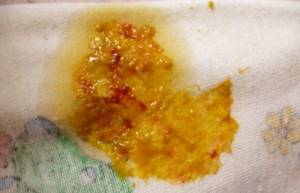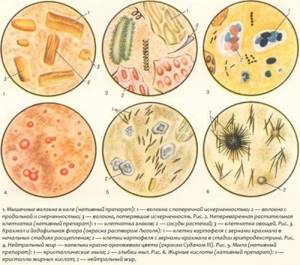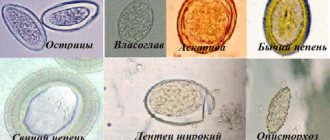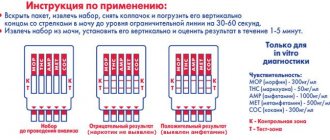Laboratory analysis of stool is necessary to obtain information about intestinal and gastric diseases, as well as to diagnose the condition of the gastrointestinal tract.
In a healthy state, feces are cylindrical in shape, brown in color and have a moderately dense consistency. As internal bleeding develops, the physical properties of stool change: bright scarlet clots or black tarry stool appear.
With hidden intestinal bleeding, the color and characteristics of the stool do not change, but clinical signs are present, the appearance of which may indirectly indicate hidden bleeding.
“A fecal occult blood test is an important diagnostic indicator in identifying many serious diseases of the digestive tract, including cancer,” comments LabQuest expert on laboratory diagnostics Yulia Sergeevna Latynina.
When and in what cases is a child prescribed a stool test? Types of stool tests.
Stool analysis in children is a very important study for problems with the gastrointestinal tract. Already by the consistency, color, smell, and the presence of impurities, you can make the first assumptions about the state of the child’s digestive system.
For a more detailed study and confirmation of the diagnosis, the doctor may prescribe: a general stool test (coprogram), a stool test for dysbacteriosis, a stool test for worm eggs, a giardiasis test, a stool test for occult blood.
A stool test for helminth eggs and a stool test for Giardia are prescribed to identify helminth and protozoan eggs that have infected the lower intestine. These tests can detect roundworms (roundworms, pinworms, strongyloides, hookworms), flatworms (liver fluke, cat fluke, pork and bovine tapeworms, echinococcus) or protozoa (giardia) in the stool. Analysis of stool for worm eggs is carried out in fresh (ideally still warm) material, no later than 3 hours from the moment of collection.
A stool test for enterobiasis can detect pinworm infestation in a child. These helminths lay eggs in the perianal folds. Clinically, this is manifested by itching in the child’s anus and intestinal disorders. Collection of material for analysis is carried out in the morning, before defecation and urination. We do not wash the child before the analysis. The analysis can be taken by the mother herself or by a procedural nurse in a clinic setting. At home, the mother uses a special cotton swab dipped in glycerin to scrape the perianal folds and place it in a special container. The container must be tightly closed with a lid. If the analysis is taken in a laboratory, the scraping is done by a nurse, and the mother can distract the baby with a toy or an exciting fairy tale. This painless procedure in our medical center is performed by experienced nurses, without causing discomfort to small patients.
A stool test for dysbacteriosis is prescribed to study the intestinal flora of a child. Based on the results of the analysis, the doctor will be able to assess the amount of “useful” intestinal microflora, opportunistic and pathogenic microorganisms. It is necessary to keep in mind: there is no diagnosis of “dysbacteriosis” and it is wrong to prescribe any treatment based on a stool test only for dysbiosis.
Coprogram. This analysis is necessary to assess the functioning of the digestive system: enzymatic activity, the degree of digestion of food, the presence of an inflammatory process in the intestines.
A stool test for carbohydrates is prescribed to infants if lactase deficiency is suspected. This test can detect congenital or acquired deficiency of the lactase enzyme.
The doctor may prescribe a stool test for occult blood if occult bleeding is suspected.
Diagnostic value of coprogram
General stool analysis is a chemical and physical study of the composition of stool to identify pathological processes in the gastrointestinal tract and monitor the dynamics of disease development.
The data obtained during the examination of the material provides an opportunity to study the functioning of the digestive processes, determine the rate of passage of food in the body and, if necessary, adjust the treatment process. In addition, the presence of Giardia, helminths and other parasitic organisms is detected.
How to submit stool for analysis?
Feces for analysis are collected in a clean, sterile container with a lid. The container can be taken from the laboratory or purchased at the pharmacy. Feces are collected with a special spoon or spatula. Fill the container no more than a third.
There are several rules for preparing a child for a stool test.
- The child's diet for 3 days should be balanced in proteins, fats and carbohydrates.
- Avoid taking enzyme preparations, drugs that affect intestinal function and the color of stool, and antibacterial drugs. If you cannot stop taking the drug, be sure to notify your pediatrician about this.
- You should not use rectal suppositories on the eve of the test.
- Avoid taking laxatives, castor oil and petroleum jelly. Do not use enemas.
The material to be tested must be delivered to the laboratory no later than 3 hours from the moment the material is collected.
When preparing for a stool occult blood test, exclude meat, liver, black pudding, apples, green vegetables, white beans, and other foods that contain iron from your child's diet.
Decoding indicators
Each of the positions being studied makes it possible to assess the work of the gastrointestinal tract organs in the most informative way. The analysis is done throughout the day and is valid for 2 weeks.
Amount of feces
A healthy person produces up to 200 g of feces per day. At standard rates, stool consists of 80% water and 20% dry material. In pathologies of the digestive organs, the volume of feces is of great importance.
For example, if there is an excessive increase in the volume of feces, there is a disruption in the absorption of food in the small intestine. A decrease in the number of bowel movements may indicate chronic colitis.
Consistency of stool
Pasty stools can vary in nature:
- Foamy stool indicates the presence of fermentation processes in the body. It can appear with heavy consumption of beer and kvass;
- with a sharp decrease in the flow of bile into the intestines due to the presence of stones or inflammation of the pancreas, ointment-like loose feces may be observed;
- loose, porridge-like stools are present when food is digested in the small intestine for various reasons, as well as due to the accelerated passage of feces;
- liquefied stool like pea puree may be evidence of a dangerous disease such as typhoid fever;
- colorless stool with the consistency of rice water is a characteristic sign of cholera;
- the presence of clay inclusions or gray masses in the feces is observed when there is a difficult outflow of bile from the liver and gallbladder, which leads to impaired breakdown of fats;
- Watery stools may be evidence of heavy consumption of water or other liquids.
Chair color
Changes in stool color with a disease such as hemorrhoids are also not uncommon:
- Blood impurities. This is due to the fact that the digested masses passing through the intestines touch the inflamed cones and cause them to bleed.
- If the stool with anorectal hemorrhoids has acquired a dark color, this may indicate intestinal bleeding. Then you should contact a specialist immediately.
- Yellow color is characteristic of stool mainly during diarrhea, and this is associated with a violation of digestive function.
If, due to hemorrhoids, the stool has acquired an unusual color, and the process of emptying causes pain, you need to go to the hospital to find out the cause.

Shape of stool
In a healthy person, feces have a cylindrical shape, with a diameter of 2 to 5 cm. Defecation occurs daily. It happens that emptying occurs every other day or twice a day, but this is also normal if there is no discomfort, constipation or diarrhea. The bowel movements should be moderately dense.
Hard stool with hemorrhoids may indicate that a person rarely goes to the toilet. This happens with frequent constipation or fear of painful bowel movements. Then the patient endures for a long time and tries to put off going to the toilet for as long as possible.
Sometimes regular thin stools indicate problems with the pancreas or other digestive organs. Therefore, premature conclusions cannot be drawn. If you are concerned about any changes in your stool, you should seek help from a doctor to find out the cause of the disturbances. Only then will it be possible to take the correct treatment measures.
Smell of feces
A healthy body “produces” feces that do not have a strong odor. If gastronomic preferences are focused on meat products, it can increase and decrease with the predominance of plant foods in the diet.
An unpleasant “aroma” is considered a harbinger of the following pathological processes:
- Chronic pancreatitis
. Failures in the production of digestive juice by the pancreas lead to poor quality food processing. This is fraught with the active activity of putrefactive organisms that secrete fetid substances; - Dysbacteriosis
. Abnormal changes in the structure of bacteria belonging to the intestinal microflora are fraught with the formation of mushy feces with a pungent odor.
A sour smell is associated with malfunctions of the pancreas.
Presence of blood
If blood fragments are detected during a visual examination, you should be checked for the following diseases:
- haemorrhoids;
- ulcerative colitis;
- dysentery.
It is not always possible to see blood without the use of appropriate equipment. An occult blood test helps detect the following pathologies:
- helminthiasis;
- peptic ulcers;
- polyposis
An increase in mucous volume, accompanied by the formation of polyps, makes it difficult for food to pass through the body. When faced with obstacles in the form of neoplasms, the food bolus damages the intestinal walls and leaves the body along with blood particles.
Presence of protein
The protein signals the possible presence of the following diseases:
- Chronic atrophic gastritis
. The production of gastric juice stops, which complicates the breakdown and processing of proteins. As a result, this compound leaves the body along with feces; - Chronic pancreatitis
. A decrease in the production of juice by the pancreas leads to the appearance of protein in the stool.
Also, undigested proteins are fraught with activation of putrefactive processes.
Reaction to bilirubin and stercobilin
Bilirubin is a bile pigment that is transformed into stercobilin under the influence of intestinal microflora. In the presence of bilirubin, predictions about pathological processes can be made. In case of dysbacteriosis, for example, this element is not converted into stercobilin and remains in the feces in its “pristine” form. Also, the main component of bile does not have time to transform in the presence of acute gastroenteritis, after severe food poisoning and the use of antibacterial agents.
The absence or significant decrease in the level of stercobilin indicates blockage of the bile duct. This is possible with the formation of benign or malignant tumors.
Excess mucus
Mucus is a substance with a jelly-like consistency that is secreted by the intestines to improve the passage of bolus food. Due to the fact that it mixes with feces, it is impossible to detect this element without a microscope.

Inflammatory and infectious processes of the colon and salmonellosis are characterized by increased mucus formation.
Muscle fibers
They are unprocessed fragments of meat products contained in feces. Exceeding the normal fiber content is called creatorrhea. It accompanies pancreatitis and atrophic gastritis. A decrease in stomach acidity and the production of digestive juices negatively affects the digestion of meat and is fraught with sedimentation of muscle fibers in the feces.

Fat and undigested food
The presence of fat in feces is considered a consequence of pancreatic dysfunction. This organ produces lipase, an element that promotes the breakdown of fat. With poor production of this compound, steatorrhea develops. This disease is characterized by the formation of oily feces with a characteristic greasy sheen. Insufficient production of gastric juice leads to accelerated transportation of feces through the digestive tract. This pathology is observed in patients with low acidity.
Presence of starch, leukocytes and pus
A large amount of starch in feces occurs when intestinal motility is overly active. If there are failures in the process of absorption of useful elements by the colon, the content of this substance may increase.
White blood cells in feces indicate the presence of inflammation. Due to the fact that the function of these blood cells is to neutralize infectious diseases, exceeding the permissible norm is a harbinger of an intestinal infection or ulcerative colitis. Pus in the stool is observed when there is severe inflammation of the colon mucosa.
Invasive diseases
Normally, this indicator should be negative. Such a conclusion means that larvae or eggs of parasites have not been identified in the body. If the result is positive, an additional blood test is performed to determine the type of helminth.
Acid-base reaction
An acidic reaction is observed during the revival of iodophilic flora. This process is accompanied by the formation of carbon dioxide and the production of acids of organic origin. Alkaline occurs with poor food processing and frequent constipation.
Presence of plant fiber and epithelium
The human digestive system does not produce enzymes to break down fiber. A large amount of cellulose is observed during rapid evacuation of food from the stomach and the syndrome of excessive growth of bacteria in the intestines. An increase in epithelial volume is characteristic of acute colitis.
Presence of yeast cells and crystals
Yeast cells form in feces after a course of antibiotics. The crystals are evidence of achlorhydria - the absence of hydrochloric acid in the gastric juice.
What can changes in stool tests in a child indicate?
Changes in stool test results in a child may indicate the development of diseases of the digestive system. By changing the color of a child's stool, one can judge the functioning of the gallbladder and bile ducts, since it is bile enzymes that color stool a specific brown color. The structure of feces can also be used to judge the pancreas and the digestion of food in the intestines. The presence of hidden blood in the stool may indicate intestinal polyps or hidden bleeding, but an admixture of bright blood in the stool in some cases may be an acceptable norm, or may indicate fissures in the child’s anus or enterocolitis. The presence of mucus in a child's stool may indicate the development of inflammation in the intestines. A sharp unpleasant odor, as a rule, indicates the development of putrefactive processes in the intestines and indirectly indicates dysbiosis. Based on the daily amount of feces, one can judge the predominance of plant or animal foods in the child’s diet.
Key indicators, their meaning and norm
The analysis includes the study of chemical, physical and microscopic properties. In the laboratory, the physicochemical properties of the collected material are studied, and the contents are examined under a microscope. Normally, stool should:
- have a mild fecal odor
. There is normally no sharp putrid or sour odor. A change in odor occurs in the presence of a large number of putrefactive bacteria or pancreatic disease. In acute and chronic pancreatitis, food is not digested, and stool becomes foul-smelling. A sour, pungent odor may be a result of inflammation - have a brown color
. Discolored or too light stool indicates the presence of obstacles to the outflow of bile (cholelithiasis, cirrhosis, hepatitis, oncology). This is called obstructive jaundice. The contents are tar-colored (even black) in the presence of bleeding in the sections (mainly upper) of the digestive tract. The causes may be: ulcer, cancer, bleeding from dilated veins of the esophagus with cirrhosis. Visible blood: bleeding from the lower gastrointestinal tract with ulcerations, polyps, hemorrhoids, cancer - be of normal consistency
. Loose, hard stools, or undigested food debris. All of these are symptoms of malabsorption in the gastrointestinal tract, decreased function of the enzyme system, and disturbances in the microflora of the colon and small intestine.

Not a single examination or treatment of a patient is complete without prescribing a general stool test.
Statistics show the extreme danger of pain under the ribs from the back, on the left side. Because this is how pathologies localized in human organs and systems show themselves. Read more in the article: “back pain on the left under the ribs at the back.”
Who can decipher stool analysis in children?
Undoubtedly, an experienced specialist should decipher the analysis of a child’s stool. Even if you independently compare the result obtained with the established standards for stool tests, a person without medical education will not be able to make a diagnosis and prescribe the correct treatment. Only a doctor at the appointment, after examining, collecting complaints, assessing the results of the analysis and additional examination, will make the correct diagnosis of the child and prescribe effective treatment.
A child of any age can undergo a stool test.
You can make an appointment with a doctor at the Center through:
online appointment form
or by calling the Center in Moscow:
+7,, +7 (962) 947-38-08
during the working hours of the Center (daily, seven days a week and holidays, from 9.00 to 21.00)
Research results
There are developed criteria for assessing feces.
The accepted standard for the condition of feces has the following characteristics:
- dense structure;
- Brown color;
- no pungent odor;
- cylindrical shape.

In a healthy body, no muscle fibers, fatty deposits, yeast or starch are detected in the stool.







